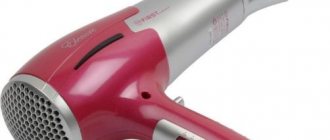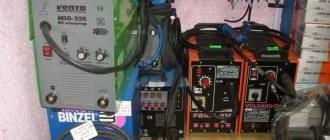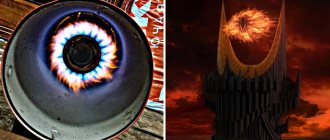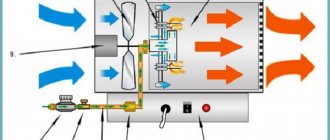In appearance, heat guns are not very different from fan heaters; in addition, they have similar functions and characteristics. Both types of heating devices are designed to quickly heat the air in a room, create a forced convection effect during operation, and are compact and mobile compared to other types of heaters.
In this article we will figure out which is better: a fan heater or a heat gun, what are their differences and for what purposes is it better to use each of the heaters.
Operating principle of the fan heater
A fan heater is a complex consisting of a heating element and a conventional fan. Depending on the heating element, it is of the following type:
- ceramic (can be glass or metal based);
- spiral (a metal spiral, most often made of chromium, is heated);
- Heating elements or tubular (a heating element and a filler with a high thermal conductivity are placed in a hollow pipe).
Spiral models are the cheapest. They heat the room faster than others, but they also fail earlier. Another disadvantage is that during operation they become very hot and the dust deposited on the elements burns. This releases combustion products into the air and creates an unpleasant odor. Ceramic and heating elements do not have this drawback.
As a rule, all fans are powered by electricity. The maximum power is 2 kW/hour, which is enough to heat a room of 10 square meters. To warm up the air in a room of this size, a fan heater with maximum power will take about 30 minutes.
They are also classified according to placement method, type of control and functionality.
IMPORTANT! Fan heaters cannot be used in rooms with high humidity, as well as near chemicals and explosives.
Comparison of several popular models and their differences
Below in the table we present 5 popular models of electric heat guns and their “younger brothers” to compare their cost and power. Perhaps you will see that a regular Chinese fan heater is quite suitable for your household needs and there is no need to overpay for more power.
| Fan heaters | Heat guns | ||||||
| Model, energy consumption | Area sq. m | Cost m2 | Cost RUR | Model | Area sq. m | Cost m2 | Cost RUR |
| Ballu BFH/S-01 1.5 kW | 20 | 39 | 780 | RESANTA TEPK-2000K (2 kW) | 20 | 75 | 1509 |
| VITEK VT-2052 | 20 | 139 | 2790 | BISON ZTP-M1-3000 (3 kW) | 35 | 56 | 1979 |
| Zanussi ZFH/C-408 1.5 kW | 20 | 92 | 1850 | Ballu BHP-P2-5 (4.5 kW) | 50 | 103 | 5190 |
| Electrolux EFH/C-5125 Prime 1.5 kW | 20 | 79 | 1590 | RESANTA TEP-3000K (3 kW) | 30 | 124 | 3736 |
| Timberk TFH T15XCZ 1.5 kW | 20 | 125 | 2500 | Ballu BHP-P-6 (6 kW) | 70 | 88 | 6190 |
Here are a few more statements from the forums about comparing these two types of heating devices.
In general, the discussion has started, now it’s your turn. By the way, the comments are just below.
Operating principle of a heat gun
A heat gun is a type of fan heater, but with much greater power. Designed to heat rooms larger than 10 square meters.
Unlike a fan, it can run not only on electricity, but also on fuel (gas, diesel fuel, kerosene). But when operating on fuel, combustion products enter the air, which negatively affects the human body.
IMPORTANT! Gas guns (directly heated) have an increased fire hazard and are prohibited for use in residential premises.
A coil or heating element is used as a heating element in the gun.
The infrared gun differs from the others in its operating principle and mechanism. It does not have the usual fan, and the air is heated under the influence of infrared radiation. The entire room is not heated at once, but only a separate section of it. Because of this feature, it is used mainly on construction sites.
Use Cases
Since there is a significant difference between the devices, the scope of their use also differs.
The fan heater is used:
- To warm up a small room or part of it, for example, near a bed or next to a table;
- For warming up an outdoor toilet in a country house or a shower stall. To do this, place two fans on the sides and turn them on for a few minutes;
- To warm up the room during the cold season. This is relevant when arriving at a dacha in early spring or late autumn. While the stove is heating up, you can heat the air using a fan;
- For drying wet things.
When figuring out which is better - a fan heater or a heat gun, it is worth keeping in mind that a fan is an excellent option for heating small household spaces in a short time.
Source onlinetrade.ru
A heat gun is used in other conditions:
- For heating large industrial premises. Its power is enough to pass through all the air in the room;
- Some low-power models are suitable for heating residential premises, as well as for greenhouses and greenhouses;
- For drying walls and plaster;
- When installing suspended ceilings.
This is a more powerful unit that can handle large areas well.
You can watch the video about the principles of operation of a heat gun and how to choose it correctly.
How does a fan heater differ from a heat gun?
The operating principle and design of these devices are the same. The main difference is power.
| Characteristic | Fan heater | Heat gun |
| Energy source | Electricity | Electricity, gas, liquid fuel |
| Power, kW/hour | 1–2 | 4–30 |
| Frame | Plastic | Metal |
The metal body makes the gun heavier, but also adds strength to it.
Another difference is in efficiency. Due to the fact that the gun can run on fuel, the cost of its operation is significantly lower.
The general drawback is that both the fan heater and the gun dry out the air and burn oxygen. They are not intended for continuous operation, and manufacturers recommend periodically ventilating the room after they are turned off.
Differences between a fan heater and a heat gun: which is better to choose, average cost of devices
Autonomous heaters can either completely replace boiler equipment and central heating, or be an additional element in creating comfortable conditions. The most common types of autonomous heaters are fan heaters or heat guns. And despite the similarity of the devices, they have differences in design and functionality.
Design and principle of operation of the fan heater
Rapid heating of the air by a fan heater is achieved through a combination of 2 elements: a fan and a heating element - a high-temperature heating element.
The device ensures air circulation, which allows you to heat a room with an area of 20-30 m2 within 15 minutes (with a ceiling height of 270 cm, you can heat a room with a volume of up to 60 m3).
Design Features
- Frame
The main element of the body is the protective grille. Its purpose is to prevent contact between the heating element and external objects, as well as to prevent burns to users.The cord compartment located at the end of the case facilitates painless installation of the device in rooms overloaded with wires.
An additional advantage for the fan heater is that it supports automatic rotation around its axis, which speeds up temperature equalization throughout the room.
Setting the hot air flow direction vertically can be especially helpful. This function ensures that cold air is quickly expelled.
- A heating element
The following types of heating elements are found in fan heaters:- Open heating element - used in the most economical devices. It heats up quickly, intensively heats the air and just as intensively dries the air and burns oxygen. To make a spiral of an open heating element, a refractory metal with a very high resistance is taken, and the spiral itself can be heated to a high temperature of several hundred degrees. It has a short service life - 2-3 years.
Closed heating element - the spiral heats the metal casing. The coil heats up almost as quickly as an open heating element, but it consumes significantly less oxygen and dries out the air.
- Ceramic plates are the current best technological solution to the issue of placing a heating coil. It is pressed into ceramic plates, forming a structure similar to blinds. Another name for such devices is plate-type.
The ceramic surface is not capable of heating above 200°C, this provides the optimal combination among fan heaters of maintaining the properties of the surrounding air and heating rate. For this reason, the operation of fan heaters equipped with a ceramic heater is accompanied by reliable fire safety and the release of “clean” heat that does not pollute the air with combustion products.A relative disadvantage of this fan heater design is the noise that occurs due to the passage of air between the plates. The “whistle” of heaters with ceramic plates can reach a level of 30-35 dB compared to 15-25 dB for their strong-smelling counterparts at the same power. However, this noise level does not cause any particular inconvenience, since it is in the same range as the so-called. "an audible whisper."
- Thermostat
This device is used to establish and further maintain the optimal temperature. The thermostat is a vessel (glass, metal, etc.), reliably protected by thermal insulation from environmental influences. Thermostats provide a constant temperature in thermostats used in household appliances.A thermostat is a device for automatically maintaining a given temperature level.
There are several types of thermostats. Fan heaters use thermostats equipped with sensors in the form of thermocouples or thermistors.
The thermostat does not control the temperature of the air in the room, but the temperature of the heating element. For this reason, the thermostat regulator, if one is installed on the fan heater, does not display the temperature value, but only symbols of the available modes.
The difference in cost between plate heaters and devices with a conventional spiral is insignificant.
What is different about a heat gun?
When choosing a heating unit, you should highlight the fundamental criteria for the effectiveness of its use. First of all, the device must fulfill its intended purpose - to heat the air. And depending on the area of the room, a power limit is set.
The functional load of a fan heater varies on average between 1 and 2 kW/h, while the design of the heat gun makes power in excess of 4 kW/h possible.
It follows from this that a heat gun can be an autonomous heating equipment for large rooms. It can heat industrial areas, garages, construction sites. With a reliable metal body, the powerful design of the gun makes it possible to operate in conditions of high humidity.
Heat guns do not depend on access to power supplies. The device can operate on waste diesel fuel or gas, while the heat fan is designed to operate only using the electrical network.
Also, the choice of heating elements may depend on the installation location. In apartments and houses, fan heaters are preferable because they are more environmentally friendly, especially devices with ceramic heating plates.
A common feature is that manufacturers of both heat guns and fan heaters have modernized the devices: today they are capable of not only heating the air, but also cooling rooms, providing the ability to switch modes. Thus, modern equipment offers 3 stages: cold, warm and hot air.
New fan heaters and heat guns are equipped with protection that turns off the device if it tips over. This mechanism reduces the risk of a fire situation.
Device cost
The cost of equipment is influenced by the following criteria:
- Manufacturer. The price is influenced not only by the affiliation with any manufacturer, but also by the quality of the build and the materials used at different enterprises.
- Heating power. It determines the size of the room that the device can heat.
- Heater type. Ceramic heating elements have the highest cost.
- Source of energy. Fan heaters and heat guns powered by electricity have a lower cost, while diesel heat guns have a higher cost.
- Additional functions. Here, manufacturers offer many options: thermostat, timer, rotary housing, remote control, ionization mode, display and others.
The average market price of fan heaters varies from 500 to 4,500 rubles. The cost of heat guns averages from 1,500 to 13,000 for electric models. Diesel heat guns cost up to 75,000.
Which is better: a heat gun or a fan heater?
The advantages of a fan heater include the following parameters:
- relatively low price;
- simplicity of the mechanism;
- compact design makes it easy to move the device;
- conservative appearance;
- safety to use.
The main negative feature is the high electricity consumption. Also, long-term operation requires ventilation of the room, since most fan heaters burn oxygen.
Heat guns have the following positive aspects:
- high power of the unit, allowing to heat large rooms;
- possibility of using alternative energy sources.
Heat guns can run on electricity, diesel and gas. If you plan to use the unit in an area where people are constantly present, then you must choose the safest source of operation - the electrical network.
The operation of gas and diesel structures is accompanied by a concentration of combustion products in the air, which has an adverse effect on human health. In most cases, such mechanisms are used in industrial premises. They can also be used for short-term work, for example, during renovations in residential premises.
The disadvantages of heat guns include the higher cost of the device and large dimensions.
In addition, given the higher power, the difference lies in the noise of the device.
Thus, a fan heater and a heat gun have a similar operating principle and purpose - quickly heating the air. And the specific type of device depends on the specifics of operation and the required power of the device.
Mar 22, 2018ventsyst
What's better?
Oil radiators are capable of heating large areas, and their safety level is high enough that this equipment can be turned on for several days without additional control.
Such devices operate silently, they are reliable and environmentally friendly, which also speaks in favor of oil radiators. But still, a fan heater or an oil radiator, which is better? This question can be answered if you know the advantages of the device, among which stand out:
- The rate of heating of the surrounding space,
- Small overall dimensions, which means mobility,
- Use at any time of the year as a heating or cooling element,
- Relatively low cost.
So in the end, you need to determine whether a fan heater or an oil heater is better, depending on the area of the room, financial capabilities and period of use of the device. Oil radiators are convenient to use in rooms where excessive noise is not desired and a high degree of safety is required. This could be a bedroom or a children's room.
(2 ratings, average 4 out of 5)










